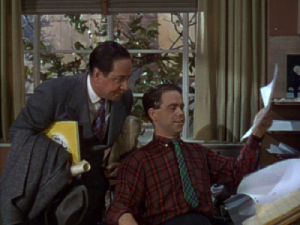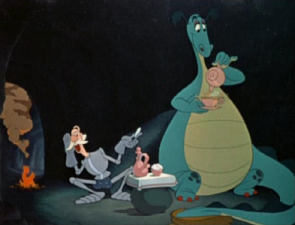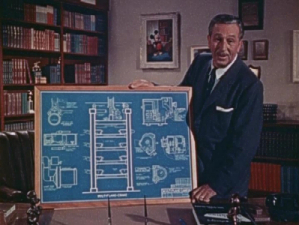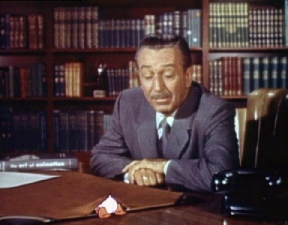Walt Disney Productions (1937-1957), Walt Disney Home Entertainment (December 2 2002), 2 disc box set, 240 mins plus supplements, 1.33:1 original full frame ratio, Dolby Digital Mono, Not Rated, Retail: $32.99
Storyboard:
A fantastic trawl through the archives that brings together all of Walt Disney’s short films, television shows, and even a feature, that deal with what he and his team did best: the making of classic animated movies. Fans will have seen excerpted clips from many of these programs, but never all together in one place fully uncut and presented in their original form. An essential set that should automatically wind up in your collections, Behind The Scenes At The Walt Disney Studios includes the full-length The Reluctant Dragon, plus the promotional documentary shorts A Trip Through The Walt Disney Studios, How Walt Disney Cartoons Are Made, and a rare first: all three one-hour original DisneyLand TV shows that revealed how the magic was made – The History Of The Animated Drawing, The Plausible Impossible and The Tricks Of Our Trade!
The Sweatbox Review:
Any Disney fan worth his or her salt will know that all that archive footage we see of Walt in documentaries and “making of” programs comes from a very small collection of films produced at the Studio promoting the making of animated cartoons. The guys creating the thunder for Dumbo, Casey Junior’s sound-effect whistle, the explanation of the Multiplane Camera – these are just some of the extracts from the live-action feature The Reluctant Dragon. Made in 1941, just before the Studio Strike burst the bubble at the supposedly happy campus the world knew as the Mouse Factory, it was Disney’s first attempt at live-action photography, as well as the unofficial first in line of the Package Features that made up most of the output from the Studio during the War-stricken and cash-strapped 1940s.
A response to the public’s thirst for finding out how Disney cartoons were made, the feature was put together featuring a number of shorts which, like many of the Package Feature sequences, would also find a life in later re-issues as stand-alone featurettes. This amazing collection, one of three new titles in the terrific Walt Disney Treasures limited edition tin sets, features this full live-action classic, as well as a myriad of other Walt-hosted specials and peeks behind-the-scenes, including the legendary Tricks Of Our Trade and The Plausible Impossible. Introductions by Disney fan and historian Leonard Maltin (instrumental in pushing the Treasures series forward) set up the discs and place the films in context. He also lets us in on a few hitherto kept secrets such as the fact that, due to Walt having no knowledge in making live-action films, filmmakers from the Fox lot came over and helped out with the making of The Reluctant Dragon! So, let’s take the tour…
A Trip Through The Walt Disney Studios (1937): This first short (running 12:19 minutes) may be familiar to some, having actually been included in the Platinum Edition of the Snow White set. Asked to create a promotional featurette on the goings on at the Studio by Walt’s then distributor RKO, who were gearing up on the release of Snow White, the Studio put this film together specifically for the theater owners. A rather serious affair, it does showcase the Hyperion Studio as well as several young faces later to become animation legends. A great addition is an amazingly informative (and optional) subtitle “commentary” which reveals an astonishing amount of information. In fact, there’s so much here, such as mini-biographies, original clip release dates and artist identification, that you may need to use your remote’s pause just to soak it all in!
How Walt Disney Cartoons Are Made (1938): Exhibitors who were shown the Trip Through The Disney Studios short encouraged RKO to adapt the film into a more “audience friendly” version for general public release. Also seen on the Snow White DVD, this 10:30 minute featurette is the result, and is a much more genial tour. Leaning more towards promoting the then up-coming Snow White, this plays well as an early example of a behind-the-scenes documentary and contains the first clips (in black and white) that a general audience would have seen of the forthcoming historic animated feature. Much of the Trip footage is utilized again here, but it is a more tightly edited piece, ending with a brief glimpse of Snow White’s 1937 premiere.
The Reluctant Dragon (1941): Following on from those initial short film documentaries, and the success of the full length Snow White, Walt was eager to produce a live-action film as well as a feature that would allow a greater depth and exploration of Studio techniques. The Reluctant Dragon, as it became known, would also act as a stopgap between his initial trilogy of films (Snow White, Pinocchio and Fantasia) and the next two in the pipeline (Dumbo and Bambi) and keep a Disney production in the theaters. The Reluctant Dragon is a hybrid film that is made up of live-action and animated segments, but it is not a combination film as the later Package Features Melody Time or Song Of The South would be, although this outing could legitimately be seen as the first in that line. Featuring a bevy of Hollywood actors posing as Studio employees, the film does actually include some real animators, and the main titles have the added touch of caricatures of the artists involved, levelling the criticism aimed at Fantasia, which didn’t name anyone apart from Walt himself in its original premiere release.
Running just over 78 minutes, the film opens with humorist Robert Benchley and the reading of Kenneth Grahame’s book The Reluctant Dragon, a short story about a young boy’s friendship with a rather anti-fire breathing dragon. Benchley soon finds himself at Disney’s with the idea of pitching the book to Walt as the subject for an animated cartoon. On his way to Walt’s office (and hounded by an over-zealous personal assistant), Benchley often loses his way, finding himself sitting in on an art class for Dumbo, and an audio recording for what appears to be the much earlier released 1936 short Mickey’s Grand Opera. The Reluctant Dragon was shot during the time that Dumbo was in production, so a lot of the tour takes in the departments involved in that feature. Visiting the Sound Department, Benchley next has a chance to catch some animation of Casey Junior that didn’t make it into the final film when he witnesses a sound dubbing session (this sequence was also a bonus feature on the Dumbo 60th Anniversary DVD).
After this first 25 minutes or so, Benchley comes across the Camera Department and the film leaves its first two black and white reels behind (“Oh, Technicolor!”). We get a peek at the still new Multiplane Camera in use, and Donald Duck shows us how he was animated for the cartoon Old MacDonald Duck, which was later released in the same year. Benchley continues his impromptu visit by stopping off at the “Rainbow Room” (with those amazing shots of all the colored pots of paint) and seeing one of the first glimpses of Bambi frolicking in the forest. Also during this sequence, keep an eye out for an early maquette version of Captain Hook from Peter Pan, in production at the Studio in the early 1940s, but delayed for release until after the return of the fully animated feature with Cinderella in 1950.
With his personal tour guide hot on his trail, Benchley stumbles into a story conference room where several “artists” (including actor Alan Ladd) insist on trying out their new short Baby Weems on him. A departure in style for Disney at the time, and never really intended for a fully-realized release, Baby Weems is perhaps The Reluctant Dragon’s standout moment. Completely told through storyboards, the sound and editing is so snappy that it zips by just like a full-blown short and certainly predates the “limited animation” techniques that would identify several studio’s work in the 1950s, most notably Hanna-Barbera’s TV output and that of the UPA Studio. Designed exclusively for this feature, it would have been fun to see a completed cartoon, but one wonders how it could ever be better than the treatment it receives here. An expertly handled sequence and great fun.

Across the hall to the Animation Department and Benchley bumps into Ward Kimball, who’s completing work on a series of Goofy drawings. After witnessing the sequence in pencil test, we are treated to a completed Goofy cartoon – the classic How To Ride A Horse (which was also issued as a separate short, but one that did not turn up in The Complete Goofy set, perhaps as its “official” release is within this feature). Finally the personal assistant catches up with Benchley and escorts him to Walt’s projection room. Here we find Disney ready to roll a new featurette which is, to Benchley’s surprise, a fully completed 20 minute animated version of…The Reluctant Dragon!

As a punch line to the film’s running gag, it’s a rather long and drawn-out joke, but it is a fun and breezy cartoon in its own right. It was later issued as a featurette using the main titles from the feature, leading to much confusion over the years as to whether The Reluctant Dragon was in fact a short or a feature. Answer: it’s both! The centerpiece of this collection, The Reluctant Dragon is a fascinating look at the Studio in its heyday, when animation was in its Golden Age and Disney’s films were second to none!
The History Of The Animated Drawing (1955): Moving on a little in time to the 1950s, and disc two features three shows from the acclaimed DisneyLand television series. Each running around 50 minutes, we join our host Walt Disney as he reveals the workings of the Studio in a way that the show’s family audiences would understand and appreciate. Always the jovial host, Walt was never afraid of opening up the processes used at the Studio to the public and these shows were the “making of” documentaries of their day. The History Of The Animated Drawing has Walt acknowledging his forebears in making drawings achieve the illusion of movement and is an entertaining and informative look back at where it all started.
A couple of great reconstructions of early pioneers’ work and methods include the complete recreation of Winsor McCay’s Gertie The Dinosaur act, as also excerpted on the two disc Dinosaur DVD, as well as an early Max Fleischer Koko The Clown short, the opening whistle from Steamboat Willie (here with an up-dated soundtrack) and generous clips from a number of Disney cartoons including The Skeleton Dance and Fantasia. As with the other two films on disc two, The History Of The Animated Drawing was shot on color film, but was originally broadcast in black and white, the only versions of these films known to have survived. Where possible, color footage has been inserted, but fans will be so used to seeing this material in black and white that it makes little difference – in fact it lends an air of “authenticity”.

The Plausible Impossible (1956): As with the “story-telling” episodes of the DisneyLand series, each show was produced with the utmost care and Walt was sure to push for high production values. This meant the individual musical scoring and editing of every episode had to match the high standard of his feature films, and it’s this attention to the show that made it such a hit at the time and keeps it fresh for today’s audiences. Gradually, even new animation was produced for these specials and in The Plausible Impossible Walt the host is joined by Donald Duck, who does not seem at all happy about having to appear on the show as a co-star! It was also the first time that audiences would have seen the discarded Soup Song sequence from Snow White in a section of the show that was not seen again until the deluxe LaserDisc release of that film in 1993 and recently again in the Platinum Edition DVD.
There is also “new” animation of a very 50s-design Mickey Mouse, who demonstrates the “rules” of being a cartoon character, and also many more color inserts – almost the entire program has remained intact (though the end credits have been digitally recreated in the style of the original). Classic Mickey is represented by the 1936 short Thru The Mirror, and Donald appears again in Donald’s Cousin Gus (1939). The segment in which Donald helps Walt out is very reminiscent of Chuck Jones’ Duck Amuck (1953) in which another duck, Daffy, is teased by an unknown animator. The show closes with the Night On Bald Mountain sequence from Fantasia (where the character we know as Chernabog is actually referred to as “Satan himself” by Walt) and is another very enjoyable excursion into the wonderful world of Disney!

Tricks Of Our Trade (1957): Again presented mostly in color, Tricks Of Our Trade delves deepest into the Studio’s animation methods. Going behind the scenes, the show explains the actual thought process used in the creation of an animated film, focusing on live-action reference to portray realistic movements with real weight and flexibility. Some fascinating footage follows the animators as they cause havoc in their offices; breaking windows, creating earthquakes, spilling milk – all in the name of pushing the boundaries of animation!
Clips from Snow White, Fantasia and Bambi illustrate the techniques, while Tricks Of Our Trade itself has often been referenced for its sequence explaining the Studio’s Multiplane Camera and how much more realistic backgrounds are rendered with its use. Most enjoyable is the section in which four of the Nine Old Men (Ollie Johnston, Frank Thomas, Marc Davis and Milt Kahl) take a ballet class (as performed by Helene Stanley, the live-action model for Cinderella) in order to properly draw the dancing hippos, ostriches, elephants and crocodiles of Fantasia. Although this is an obviously staged event (Fantasia, of course, was released years before, in 1940) it leads into the closing excerpt nicely and leaves this particular look at the Disney Studio with a smile on our faces!
Is This Thing Loaded?
Disc one opens with a look at the first four titles in the Walt Disney Treasures line: Silly Symphonies, Mickey Mouse In Living Color, Disneyland U.S.A. and Davy Crockett. In the Bonus Material section, there’s a nice array of additional features relevant to the programs on the disc. First up is Leonard Maltin’s Studio Tour, a look at the history of the actual Studio lot, from the early Alice Comedies, through the classic shorts and the animated features, to the buildings of today. With a lengthy 24 minute running time, it packs in a ton of information and Maltin’s enthusiasm shines through in his motor-mouth vocal delivery. There’s a little overlap between the clips and the shows included in the set but this really is a great overview, revealing a few golden nuggets of information (for instance the fact that the 50s detective drama Dragnet was shot at the Disney Studio), and also features the complete additional short Back Stage Party!
Behind The Boards On Baby Weems is a six-minute look at the creation of The Reluctant Dragon’s highlighted segment, Baby Weems. After a brief look at storyman Joe Grant’s Disney career, the man himself reveals Studio production stories and the development of the Weems short in an interview with Maltin. Grant opens up and expands on information given elsewhere in the set, and it is simply magic to see this man speaking about working at Disney back then, knowing that he was still contributing to the Disney films of today up until his death.
The Reluctant Dragon Gallery features a series of production stills promoting, and from the making of, the feature film. The Walt Disney Studios Gallery provides a second collection of archive photographs centered on the Studio surroundings in its heyday. Quite a few of the images have been utilised in the programming but it is nice to have a chance to stop and study them in detail.
As disc two features almost three hours of programming, there’s slightly less space for any more extras, but what are on offer are fascinating. The Kem Weber Gallery features a number of archive stills highlighting his design of the Disney Studio. The first photo offers up more information via an audio segment narrated by Maltin and again he packs in much background knowledge about Weber and his influences in designing the Studio blueprints and concepts.
A lengthy 1946 radio program originating from Australia contains interviews with the writers and artists at the Studio (including Eric Larson and Walt himself) as the host is talked through the animation process. Although the whole program has obviously been scripted and is merely being read aloud, there is a wonderful sense of nostalgia in the segment and the sound is in remarkably good condition – again revealing yet another great piece of trivia: did you know that Alice In Wonderland was originally intended to feature a live action Alice in a cartoon world?

Since this set already plays like an extended collection of supplemental material itself, the inclusion of further extras is simply the icing on the cake! Leonard Maltin should be praised along with the regular Disney DVD producing team of Jeff Kurtti and Michael Pellerin for yet another great helping of classic Walt!
Case Study:
Presented as with the other sets in the Walt Disney Treasures line, the Behind The Scenes At The Walt Disney Studios thick-styled double keepcase comes housed in a limited edition tin. Inside, we find a lithograph reproduction print of the theatrical poster for the original feature release of The Reluctant Dragon, as well as an eight-page booklet, which gives a general outline of the set and an in-depth analysis of its program contents. Sheer class.
Ink And Paint:
There’s really not too much to say about the visual quality of the material collected in the Behind The Scenes At The Walt Disney Studios set. The film footage elements used are of varying quality, and while it’s fair to point out that none of it looks restored in any way, it is also fair to say that it also doesn’t look shabby in the slightest. Strangely, The Reluctant Dragon feature zips in and out (but unnoticeably) between full-frame and a very slight “windowboxing”, which preserves the entire filmed image and allows for the “overscan” effect of screen displays – very welcome so that the picture is not further cropped. This is real collector’s material – priceless to the fan, but not a money-spinner on the whole – and as such the films presented are showing their age, but wearing it well. There’s a certain feeling that these shows should have the odd blemish and scratch, and the clips from the films make for intriguing comparisons to the digitally spruced up versions appearing on other discs. The program line-up has correctly been rightly spread over the two discs, and there is no visible artefacting or degradation of material due to compression or digital mastering. In short, these films look just as they should!

Scratch Tracks:
As with the video, the audio is just what you might expect. Presented in Dolby 2.0, everything is pretty much in mono, with the very occasional hint of stereo music. Walt took a great deal of care over the audio presentations of his productions and these mixes show it – not a word is lost due to overloud sound effects or music, while those elements are also clean and free of distortion. Extremely well recorded at the time, and reproduced with an amazing clarity, there is nothing wrong with any of the soundtracks in this set. English subtitles have also been included.
Final Cut:
What with the issue of the fantastic documentary Walt: The Man Behind The Myth and this collection on DVD, fans really can celebrate what would have been Mr Disney’s 100th birthday in style! Released just days before the end of Walt’s Centenary year, and a perfect companion piece to the Myth film, Behind The Scenes is a tour like no other. Perhaps it would have been nice to extend the modern day glimpses and see the site as it is now, but this chiefly deals in Walt’s time. Not only does it really take you on a trip to see behind the magic, but this set also features some of the most important Walt footage known to exist. Fans just shouldn’t need telling, and anyone interested in animation as an art form should take a look. The long and the short of it is…grab this set while you can!!
 | ||
 |








